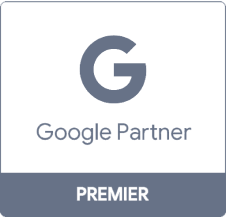- Home
- Email Marketing
- Learn
- How to Build the Best Email Marketing Strategy in 2025
How to Build the Best Email Marketing Strategy in 2025
Email is one of the oldest and most effective forms of digital marketing. In fact, for every $1 you spend on email marketing campaigns, you have the potential to earn more than $40 in return.
This is a higher ROI than any other digital marketing channel –much higher than traditional advertising – and it’s one that businesses in every industry can use. After all, most adults with Internet access check their email at least once every day. So regardless of who your target audience is, there’s a strong chance you can reach them with email.
Earning such a high ROI isn’t as simple as sending newsletters or promotions whenever you think of it, though — it requires thorough email marketing planning and a smart email marketing strategy.
Keep reading to learn about the most effective email marketing strategies in 2025 for B2B and B2C organizations and how to create email marketing strategy that drives ROI.
Looking for email marketing help? At WebFX, we have years of experience creating and managing effective email campaigns for our clients, so we know what works (and what doesn’t). And if you’re ready to start getting real results from email, we’d love to help.
Contact us today to learn how WebFX can help your company earn new leads and customers with email.
WebFX is a Partner in Driving Results
Hear from HydroWorx, who saw a 131% increase in organic forms by partnering with WebFX
1. Choose an email marketing platform
The first step to launching an email marketing strategy is selecting a platform.
There are many email marketing platforms available today that offer list management, templates, automation, and virtually everything else you need to create an effective email marketing strategy plan and manage campaigns.
At WebFX, we include our own proprietary software, EmailMarketingFX, as part of our email marketing plans. We also use it for all of the campaigns we send to our own subscribers.
There are many other email marketing platforms available, and the one that’s right for your business depends on your needs and goals.
However, there a few key essential elements that you should look for as you research your options.
- List management: Control your list of subscribers and divide them into segments
- Templates and customization: Create emails based on pre-made, effective layouts
- Mobile-friendliness: Make your emails display properly on any device
- Analytics: View metrics like open rate, click-through rate, and bounce rate
- Testing options: Refine your email strategy with A/B tests and monitor the results
- Automation (optional): Funnel new subscribers into tailored campaigns that keep in touch with a recipient on their own
We’ll go into more detail on each of these elements throughout the rest of this page, but if any of the platforms you’re considering don’t offer one or more of them, you may want to eliminate them from your search.
Even if you aren’t planning to create automated campaigns or run A/B tests, you may want to try these features in the future. Upgrading to a new plan is much easier than getting a new email marketing provider.
2. Build and organize a list of subscribers
Once you’ve selected your platform, you need to build a list of subscribers as the next part of your email marketing strategy plan.
This is one of the more challenging email marketing strategies, as it requires you to convince your target audience to give you their contact information.
But as you grow your list, you build an audience that you know wants to hear from you. That’s an advantage that virtually no other marketing channel can offer.
So how do you earn that audience?
The first step is adding opt-in forms to your website.
If you’ve spent any time shopping or reading blogs online, you’ve seen pop-ups like this one from Under Armour asking you for your contact information:
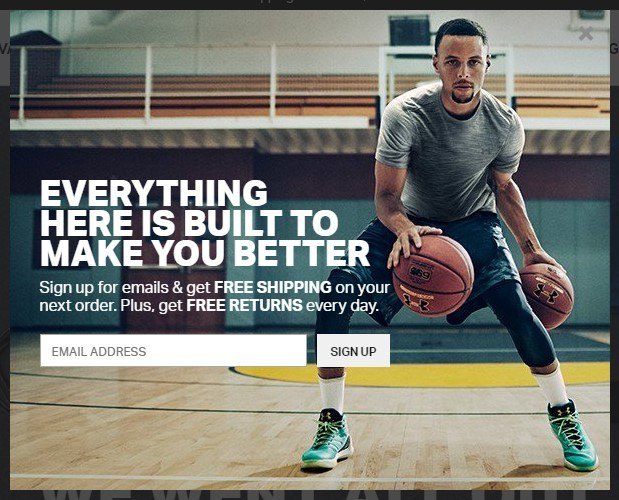
In most cases, these pop-ups offer something in return for your email address — in this case, free shipping off your next order.
The incentive you offer depends on your industry and business model. If you’re an ecommerce store, you can offer visitors discounts on their next purchase or free shipping. And if you’re a B2B software provider, you could offer users a 30-day free trial.
The important part is that you offer something in exchange for contact information. Most Internet users are wary of handing out personal information, and there needs to a clear advantage to them for giving you their email addresses.
You can also include these forms in other places on your site, like your footer, sidebars, and even at the ends of site pages.
As you set up these forms and collect email addresses, you should create segments within your main subscriber list for different subsets of your target audience.
For example, if you run an athletic apparel store, you could have separate lists for visitors who opt into your email campaigns on pages for women’s clothing or men’s clothing.
Then, when you create your campaigns, you can send your subscribers information they want to read.
The segments you create depend on your target demographic, but businesses in all industries can benefit from this strategy.
In fact, list segmentation yields 39% more opens and 28% fewer unsubscribes than sending emails to one general list of subscribers.
You can begin by creating different segments for opt-in forms on different parts of your site, then move to more advanced segmentation based on demographic and firmographic information.
This requires more work than simply compiling a master list of recipients, but results in more targeted and effective campaigns.
3. Create drip campaigns
Regardless of your business model, most of your target audience won’t be ready to convert during their first visit to your site. They’ll need time to research their options, consider if they really need what you’re offering, and even consult other decision-makers at their businesses.
You may think that you have no say in this process, but at WebFX, we always keep the focus on leads and revenue, and look for new ways to move leads through the sales funnel. As a result of this focus, we’ve driven over $10 billion in sales and 24 million leads for our clients — and one of the ways we’ve accomplished this is with automated emails campaigns.
If you’re able to get a user’s email address during one of their initial site visits, you can use drip campaigns to stay in contact and move them through the sales funnel as part of your email marketing planning.
Drip campaigns are made of pre-written emails that are automatically sent on a pre-set schedule based on when a user opts into your lists.
They’re designed to provide timely and relevant content recipients based on where they are in the sales funnel and encourage them to take the next steps towards conversion.
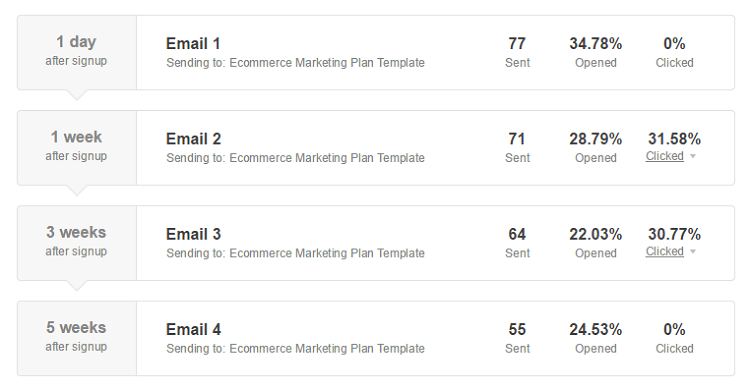
For example, if you place an opt-in form at the end of a page about a service, you could send them an email linking to a similar page three days later.
Then, a week after that, you could send another message recommending a free guide that tells them more about the service that originally interested them.
A week after that, you could send a follow-up encouraging them to speak with someone from your sales team.
By automating these emails, you eliminate the burden of remembering to follow up with each of your new subscribers You also eliminate the risk of overwhelming them with too much information at once by pacing your message delivery.
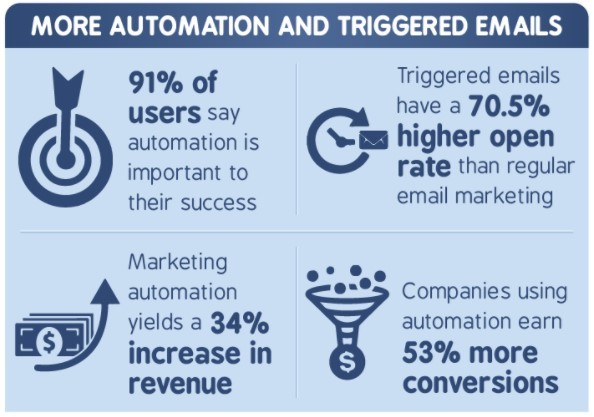
By using this email marketing strategy, you can reach your new subscribers at crucial stages in the buying process and provide all of the information they need to make an informed decision.
By the final email, they should have an accurate idea of whether they can benefit from your services and an easy way of contacting you to learn more.
Explore: How to Create an Email Marketing Calendar
4. Personalize your content
Personalization is becoming increasingly important in all forms of digital marketing, which makes it one of the best email marketing strategies for 2025.
Personalization options have significantly improved over the past few years.
Marketers used to only have the option to add basic elements like the subscriber’s first name in the greeting. While this is still a widely-used practice, the options today are more helpful for subscribers and more effective for businesses.
One of the best ways to personalize your email campaigns is to include content based on an individual subscriber’s previous actions on your site.
For example, if an Airbnb user browses rentals in a specific city while logged into their account, the company often follows up with more options in that city.
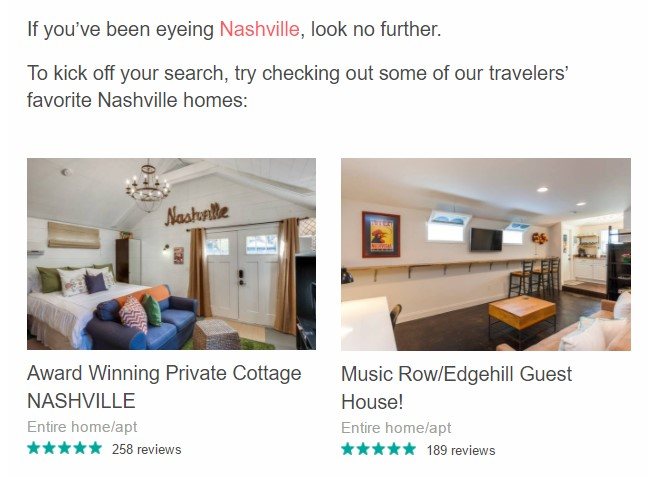
This is much more likely to gain that subscriber’s attention because it’s relevant to what they already searched.
And unlike a drip campaign, which is pre-set from the moment someone subscribes, personalized emails are based entirely on what a subscriber likes.
As a result, personalized calls to action convert 42% better than generic ones. So if you’re just starting with personalization, your first area of improvement could be calls to action.
Although many companies use personalized elements in emails, you can take this a step further by creating entire personalized campaigns.
This is called lead nurture email marketing, and it’s designed to provide each of your subscribers with the right content for their specific needs.
Lead nurture campaigns follow the same basic principles as drip campaigns, but they change based on the actions of each subscriber.
So instead of sending emails based solely on a user’s original signup date, you can also set up your campaign based on links recipients have clicked in previous emails, the actions they’ve taken on your site, and whether they’re already a customer or lead.
These actions all give you a better idea of where each lead is in the sales funnel, what kinds of content they like, and the information they need to convert.
Lead nurturing campaigns also provide your subscribers with a seamless experience across your site and their inbox.
For example, if they’ve recently read a specific blog post on your site, it wouldn’t be helpful to send them an email with a link to that same post.
With a lead nurture campaign, you could avoid that redundancy and encourage them to visit another page on your site that’s more likely to convert them.
5. Send reminder emails
Similar to lead nurture campaigns, individual reminder emails are an effective way to re-engage subscribers and bring them back to your site. In fact, these triggered emails can increase conversions by 50%.
One of the most effective forms of this is shopping cart abandonment emails.
If you’ve ever added products to your cart on an ecommerce site without completing a purchase, you’ve likely received an email like this one:
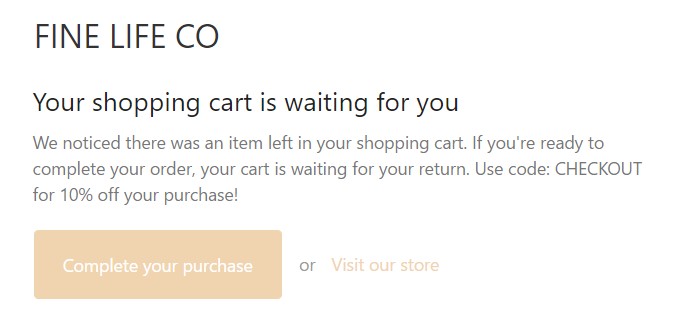
These emails work because they not only remind users of an item they wanted, but make it easy for them to return to the site and buy it, and the example here is particularly compelling because the email also offers 10% off the product that was abandoned in a user’s cart.
If you run an ecommerce store, this is by far the best reminder you could set up for your email marketing strategy. And even if you don’t add an incentive like a discount, you’ll still see positive results.
While many B2B businesses don’t have the clear-cut choice of shopping cart abandonment emails, they can still use triggered reminders to bring subscribers back to their site.
Eventbrite, for example, sends reminders like this one to subscribers who haven’t engaged with any of their emails for several months:
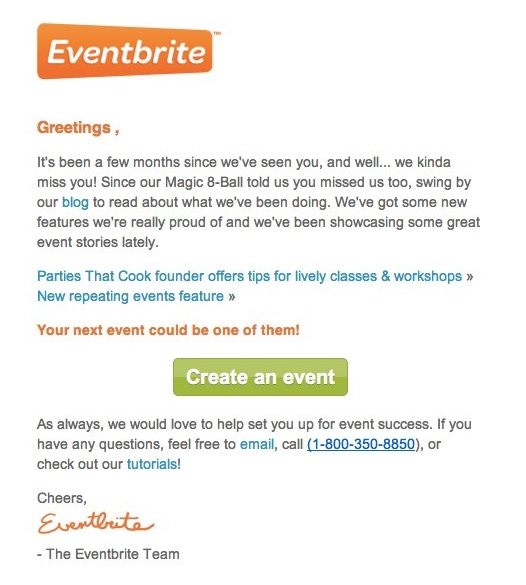
Instead of linking to specific products, they remind subscribers of what they have to offer and encourage recipients to read case studies to see how other users have benefitted from Eventbrite.
If a large chunk of your subscriber list is inactive, this kind of email could be exactly what you need to regain their interest and get them back into your sales funnel.
6. Test and improve
As with any digital marketing strategy, one of the most important parts of email marketing is testing and improving your campaigns.
Your testing options depend on the platform you use, but almost every platform offers basic A/B testing.
The best place to start with this is by running A/B tests on your subject lines. All you need to do is write two different subject lines and send both variations to your subscribers.
Then, after a set amount of time, your email provider will select the version with the higher open rate and send that version to the rest of your subscribers.
At WebFX, for example, we write two subject lines for each of our emails, send them to 10% of the users on our list, and send the higher performing version to the remaining 90% of users after an hour.
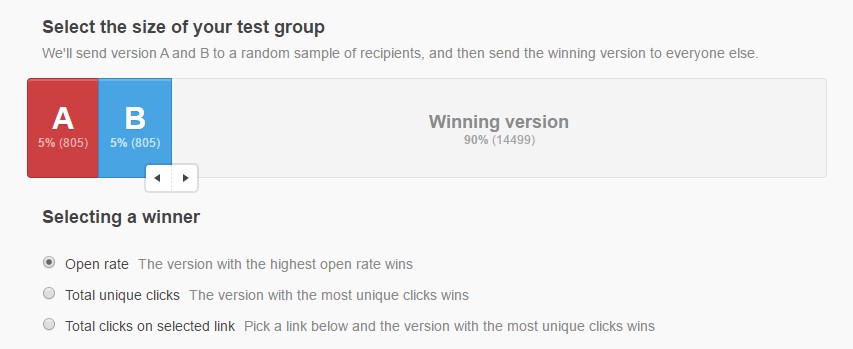
These tests only take about a minute to set up but significantly impact open rates.
Tests aren’t limited to subject lines, though. You can test virtually every element of your emails, including:
- Subject line
- Content
- Calls to action
- Templates
- Send times
After subject lines, your calls to action are the highest-impact elements you can test.
For example, if you use text like “Click here” or “Read more,” you could test out new phrases like “Download your free guide!” or “Shop now!”
You can also test out different ways of presenting your calls to action.
If you usually use text-based links, you could try switching to more eye-catching buttons. If you already use buttons, you could test them in different colors or change the quantity you include in each email.
From there, testing the appearance of your emails can also yield some surprising results. Add some visual interest to make your messages more compelling for your subscribers.
And if you normally use a catch-all, corporate-looking template, switching to text-based emails from a specific member of your team could help lend a more personal feel to your campaigns.
Finally, sending your emails on different days of the week or different times throughout the day can show you when your audience is most interested in hearing from you.
If you improve your open rates even by a percentage or two by sending your emails on Wednesdays rather than Thursdays, that could mean a few hundred more users reading what you have to say.
[ta name=”20″]
Put these email marketing strategies into action with WebFX
Creating an effective email marketing strategy is challenging. After learning how to create email marketing strategy, it requires time, experience, and understanding of your target audience to build a list of subscribers and provide the content they need. On top of that, you need patience and constant testing to improve your campaigns and earn the best possible results.
At WebFX, we understand all of these challenges and we have years of experience creating effective email marketing campaigns for our clients. If you’d like to learn more about the results we’ve achieved, feel free to check out our 1,100+ client testimonials — more than any other agency in the United States.
This dedication to email is also we developed EmailMarketingFX — to create the best possible campaigns for our clients.
Today, we’ve grown the platform to include testing, analytics, and the capability to build advanced campaigns that keep subscribers engaged and move them through the sales funnel.
We know what it takes to succeed with email marketing, and we can help your company use it to reach your goals.
Learn more about building your email marketing strategy
If you’re interested in creating a custom email marketing strategy, or want to learn more about how your company can use email to reach your goals, we’d love to hear from you.
Contact us today to speak with a strategist and get a free quote!
Related Resources
- 6 Qualities of a Good Email Marketing Campaign
- 7 Tips for Building an Email Marketing List That Converts
- 8 Best Email Marketing Tips for Your 2025 Campaigns
- How to Amplify Your Digital Marketing Assets Through Email Marketing
- How to Create an Opt-In Email Marketing Strategy
- How to Increase Email Open Rate: 5 Tips to Get Started
- Targeted Email Marketing Campaign
- The 6 Different Types of Email Users and How to Market to Them
- We Studied 6,713 Holiday Marketing Emails. Here’s What We Uncovered
- 12 Holiday Email Marketing Tips
Marketing Tips for Niche Industries
- Healthcare Email Marketing: 5 Strategies for Hospitals
- Healthcare Email Marketing: 5 Strategies for Hospitals
- How Can Email Marketing Help Your Dental Practice?
- How Can Email Marketing Help Your Dental Practice?
- Insurance Email Marketing for Agents & Companies
- Real Estate Email Marketing: Your Guide to Email Marketing for Realtors
- Simple and Successful Email Marketing Tips for Construction Companies
- Simple Email Marketing Tips for Home Services Companies
- 29 Healthcare Email Examples to Inspire Your Strategy
- 3 Effective Heavy Equipment Email Marketing Strategies







